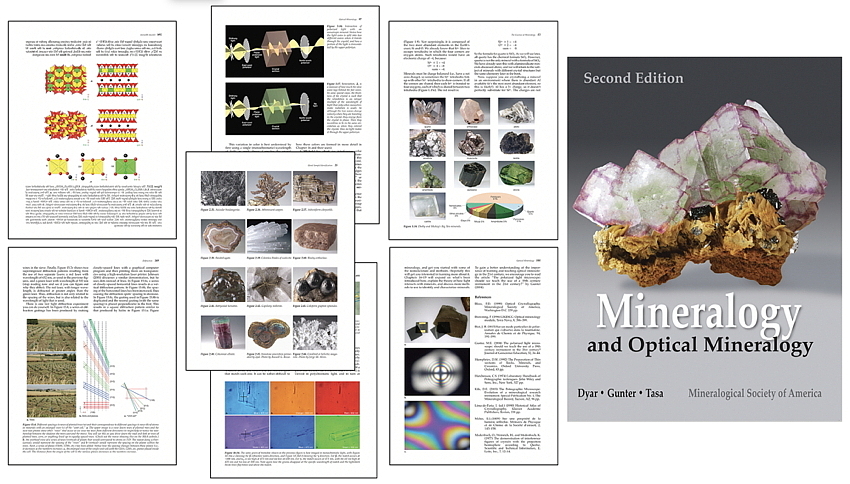
Mineralogy and Optical Mineralogy
Written by M. Darby Dyar and Mickey E. Gunter
Illustrations and animations by Dennis Tasa
ISBN 978-1-946850-02-7
Jump to:
Textbook Description
Mineralogy and Optical Mineralogy is a college-level textbook designed for courses in rocks and minerals, mineralogy, and optical mineralogy. It covers crystallography, crystal chemistry, systematic mineralogy, and optical mineralogy. The textbook is organized to facilitate spiral learning, with introductory through advanced chapters on each of these four topics. A chapter on hand sample identification is also included.
The chapters differ in several ways from a traditional mineralogy textbook: (1) it promotes learning in a digital environment; (2) the authors use modern pedagogy; (3) it is written so that the more advanced chapters build on information learned in earlier chapters; (4) each chapter in the digital series is available separately allowing the instructor to pick and choose only those chapters needed for their specific course. Table of Contents and Preface as a pdf.
Figures
Link to all the images, animations, and videos that accompany the textbook. These can be viewed free by anyone.
Textbook formats, Where to Buy
Mineralogy and Optical Mineralogy is available in print as a full color paperback, in electronic form (pdf) as both the complete text and as individual chapters, as well as individual chapters for iPad and Mac on iBooks.
Buy the print Textbook (2019 color edition) Here.
Buy the print Textbook (2008 B&W edition) with DVD-ROM Here.
Buy individual chapters or complete Textbook (2019 color edition) as pdf's Here. (Choose "Textbook" from the pull-down menu.)
Buy individual chapters for Apple iOS devices (iPad, iPod Touch, iPhone) Here.
CrystalMaker
Mineralogy and Optical Mineralogy is specifically designed to take advantage of digital media technology to empower students and teachers of mineralogy. Using color photographs, illustrations, movies, 3-D rotatable crystal structure models made with CrystalMaker®, interactive diagrams, and review questions, this series makes a challenging subject approachable.
CrystalMaker® Software is an integrated suite of three excellent programs - each requiring basic crystal structure data as input: 1) CrystalMaker is used to view crystal structures and explore their characteristics, 2) CrystalDiffract is used to simulate powder diffraction patterns, and 3) SingleCrystal is used to simulate single crystal diffraction patterns. These programs run in demo mode until they are purchased. In demo mode the programs are limited, but can be used to view most of the material shown in Mineralogy and Optical Mineralogy. All three programs are available for both Mac and Windows platforms, along with much more through descriptions, at http://www.crystalmaker.com.
Available in a zipped folder CrystalMaker_files are all of the CrystalMaker input files used to make the illustrations in the Mineralogy and Optical Mineralogy. They are grouped in folders by chapter number and have file names that begin with each figure number; the rest of the filename is somewhat cryptic and means more to the authors than anyone else. These files can also serve as input files for both CrystalDiffract - to produce simulated powder diffraction patterns or SingleCrystal - to produce simulated single crystal diffraction patterns.
Available in a zipped folder CrystalDiffract_files are the all of the files made specifically for use with CrystalDiffract to produce the illustrations in Chapter 15. Again, the beginning of the file name corresponds to each figure.
Mineral Database
Compiled by M. Darby Dyar and Mickey E. Gunter and illustrated by Dennis Tasa, the Mineral Database provides a quick, portable reference for students, educators, professionals, or anyone interested in minerals. This searchable database app provides a quick reference for students, educators, professionals, or anyone interested in minerals. It contains hand sample photos, photomicrographs, physical properties, crystal animations, 30 structures, and more for 300 common mineral species. No internet connection is required. Ideal for field use.
Buy the Mineral Database for the iPhone, iPad or for the Android Here. (scroll to the bottom of that page.)